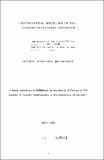Mathematical modelling of the Olkaria Geothermal Reservoir
Abstract/
The basic equations which govern the flow of fluids in a geothermal reservoir (often a two-phase mixture of steam. and water) are outlined. The governing nonlinear system of partial differential equations that arises is solved by numerical methods which involve replacement of both the spatial and time derivatives by their finite difference equivalents. The equations that result are nonlinear and are linearized using the Newton-Raphson procedure. These equations with their solutions are applied to the Olkaria geot hernial reservoir. Two significant variables, namely pressure and enthalpy change are modelled. Both variables are investigated for the present producing reservoir of Olkaria East field and the anticipated extension to the Olkaria North East field which is to have an installed capacity of 64MvVe. In order to examine these variables by modelling, two models are set up i.e the natural state model of the field before exploitation and a production model which gives the response of the reservoir to exploitation for electricity generation. The solutions to the models are generated by the MULKOM computer program. The main aim of carrying out this study is to model exploitation of Olkaria East field with a capacity of 45MWe extension of exploitation to the Olkaria North East field with a capacity of 64MvVe, and to assess if Olkaria North East field can sustain the said capacity for a period of 20 years. The natural state model which occupied a surface area of '~l2..km. x 22km. had heat inputs at the base of some of the reservoir blocks. When this model is run over a long period of time, the simulated pressure and temperature, to a reasonable degree of accuracy, matches the observed values at any given location in the field. The actual process of simulation includes inserting heat of a certain magnitude at specific locations at the bottom of the reservoir to represent magmatic bodies. The system is then heated over a long period of time until the temperature and pressure resemble those we observe in the field by measurements. The production model uses these parameters together with reservoir enthalpy as starting information. Each reservoir block was assigned specific values of pressure, temperature, enthalpy etc. As withdrawal of fluids from the reservoir for electricity generation commences. these parameters change with time. These changes a.re calculated by the !\IULEOi\I program which enables us to find the values of these parameters at. any location and time in the reservoir. Production using a 45MWe power station from Olkaria East field was simulated for 14 years of production from 1981 to 1995. The production was then run for another 20 years from 1995 to the year 2015, this time with an extension to 011<3.- ria Nort.h East field with a station capacity of 64MvVe. The future status of the reservoir in terms of fluid enthalpy and pressure changes were predieted for the period 1995 - 2015. The results of this simulation indicate that <:1 pressure drop of 15 bars is likely to occur over the latter production period. The average production enthalpy is predicted to range from 1350k.J/kg in the year 1995 to 1780k.J/kg in the year 2015. The above enthalpy range shows that the target of 64MWe power generation for 20 years may be met. without the enthalpy "rising too high( an indication of the increase ill vapor-phase in the reservoir). However, a drop of 15 bars in reservoir pressure may call for drilling of extra make-up wells to sustain the 64MV/e power generation for 20 years.

